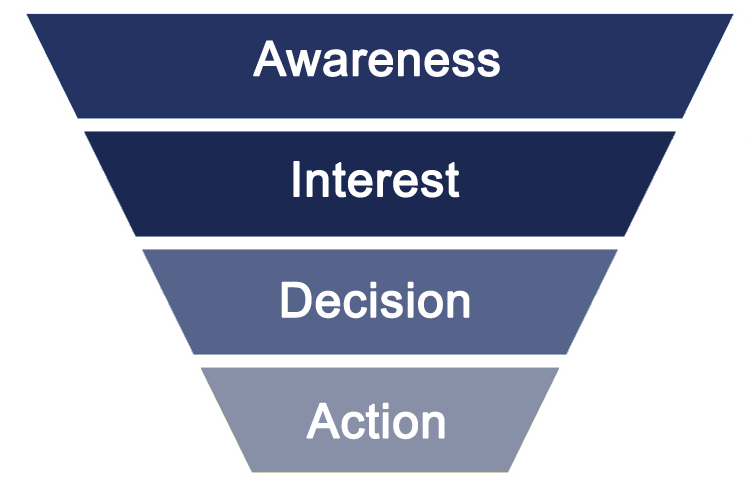How do your nonprofit communications work together? Do you simply put the same message out through your social media channels, your email list, your direct mail list, and your website? Let’s talk about how your communication can work together. Let’s talk about the marketing funnel, also called the sales funnel or donor funnel. Here are the highlights, before we get into the nitty gritty below:
Overview
- As the audience moves down the funnel, the intimacy between the audience member and the organization increases.
- The funnel decreases at each stage. You lose audience members at each transition. That’s okay.
- You want to decrease that loss from stage to stage. This can be done with smart targeting.
- The funnel should be built for a specific audience with a specific goal in mind.
- Give the audience a breadcrumb to move from one stage to the one below. Calls to action can be critical to making that happen.

Details
1. Increasing Intimacy
Perhaps you’ve heard of fundraising likened to a personal relationship. You find people who interest you (potential funders), you reach out to them, and then try to develop a relationship. You email, call, send them mail in the hopes of sparking their interest. You want to increase their trust in you before you pop the question, “will you make a donation?” This is an important idea that the donor funnel illustrates. As your audience becomes aware of you and the solutions you offer (Awareness Stage), you use different forms of communication to build that trust. You bring them closer to the organization (Interest & Decision Stages). Finally leading them toward an action you want them to take to support your organizational goals (Action Stage). In keeping with the metaphor, this concept would be likened to polyamory or perhaps polygamy (we’re not judging). You want to do this over and over with new donors/volunteers/partners/etc. You want to find new ones while nurturing the past ones to maintain those relationships.
2. Decreasing audience size
The funnel is a funnel for a reason. It’s not the marketing rectangle or the marketing linear downward arrow for a reason. It is expected that your targeting will include some people who may not be compelled to move to the next stage of the funnel. That’s okay. You can’t win them all.
3. Targeting
While loss is expected from one stage to the next, you want to minimize that loss. You can do this from the top of the funnel (TOFU) by targeting the specific audience that is likely to take the goal you are focusing on. Your audience is not a monolith, nor is everyone in the world part of your audience. By narrowing your focus on specific groups, you are able to hone the message. You can distribute it in the channels where you find that audience. You can personalize your outreach to better convince that audience to support your cause.
4. Specific audiences-specific goals
Your funnel should be designed with a specific audience in mind leading to a specific organizational goal. For example, your educational nonprofit is targeting education-major senior year undergrads for volunteering. From the top of your funnel (Awareness Stage) down through each subsequent stage, each communication is oriented towards that audience segment and driving them towards volunteer sign up (Action Stage).
5. Calls to action
You can also decrease loss as the audience moves down the funnel by creating clear Calls to Action (CTAs) from one stage to the next. For example, let’s refer back to the target audience of education-major senior year undergrads. At your (Awareness Stage) event at a college campus outside the education building you encourage attendees to sign up for the (Interest Stage) newsletter. The newsletters/emails that go out to these sign ups publicizes another upcoming event at which you need volunteers. A CTA on the email directs them to a (Decision Stage) page on the website dedicated to volunteer sign ups for the event. The page itself has a strong CTA button to sign up to volunteer (Action Stage).
